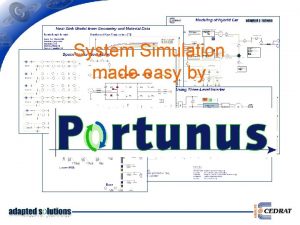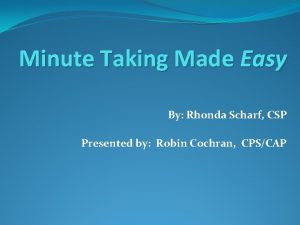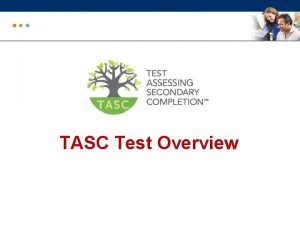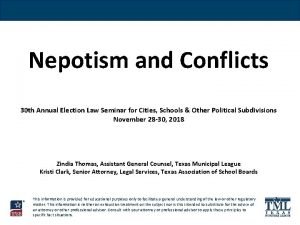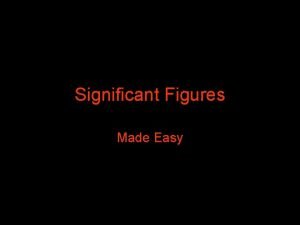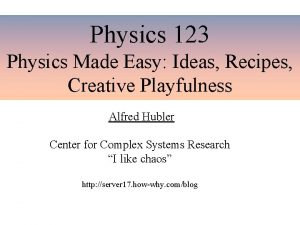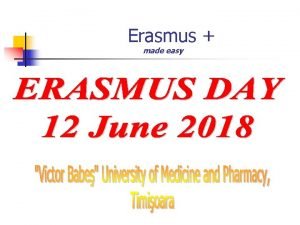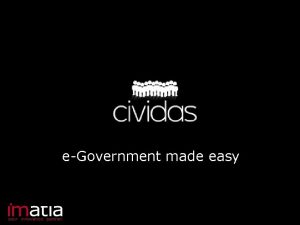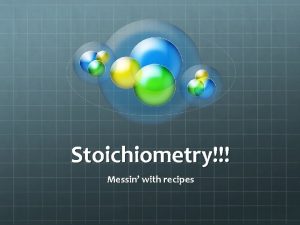Physics 123 Physics Made Easy Ideas Recipes Creative












- Slides: 12

Physics 123 Physics Made Easy: Ideas, Recipes, Creative Playfulness Alfred Hubler Center for Complex Systems Research “I like chaos” http: //server 17. how-why. com/blog

Todays topics: - Scientific Method - Uncertainties, Reproducibility, and Testing of a Hypothesis

Scientific Method Context: A belief system- “What is true? ” Scientific method: Use past to predict the future. Discussion: -Other belief system include faith, intuition, traditions. -Scientific method works well for simple systems.

Uncertainty, Reproducibility, and Testing of a Hypothesis Sources of uncertainty: -No units, bad units, inconsistent units -Uncertainty in the design of the experiment, -i. e. when is the cup of macaroni really full, are all cups of the same kind, etc. -Uncertainty in the measurement, -i. e. counting errors; experimental resolution. -Noise, or other irregular, unknown forces are important, -i. e. in a coin flip: high sensitivity to noise, history, context = chaos Bottom line: Uncertainty is OK. Measurements are reproducible if they agree with the error bars (bad units => large error bars). Testing: Hypothesis is correct, if the model prediction matches the experiment within the error bar, but good science = small error bars

Growth of Fractal Networks: Chaos needle electrode sprays charge over oil surface 20 k. V air gap between needle electrode and oil surface approx. 5 cm ring electrode forms boundary of dish has a radius of 12 cm particles are non-magnetic stainless steel, diameter D=1. 6 mm oil height is approximately 3 mm, enough to cover the particles sit on the bottom of the dish castor oil is used: high viscosity, low ohmic heating, biodegradable

Phenomenology Overview 12 cm stage I: strand formation stage II: boundary connection t=0 s 10 s 5 m 13 s 14 m 7 s 14 m 14 s 14 m 41 s 15 m 28 s 77 m 27 s stage III: geometric expansion stationary state

Adjacency defines topological species of each particle Termini = particles touching only one other particle Branching points = particles touching three or more other particles Trunks = particles touching only two other particles Particles become termini or three-fold branch points in stage III. In addition there a few loners (less than 1%). Loners are not connected to any other particle. There are no closed loops in stage III.

Relative number of each species is reprodicible: 22% termini, 22% branching points Graphs show the number of termini, T, and branching points, B, scale with the total number of particles in the tree.

Qualitative effects of initial distribution Slightly different initial condition produces very different number of trees =>chaos

? Can we predict the structure of the emerging transportation network?

Predicting the Fractal Transporatation Network Left: Initial condition, Right: Emergent transporation network

Today’s topics: Scientific Method Idea: Use observations to predict the future Definition: A scientific method consists of the collection of reproducible data through observation , and the formulation and testing of scientific models which predict these observations. Uncertainties Design Flaws, Measurement Uncertainty, Chaos Testing Hypothesis is correct, if model prediction is within the error bar.
 Physics ia example
Physics ia example Inductive vs deductive geometry
Inductive vs deductive geometry Deductive vs inductive geometry
Deductive vs inductive geometry Every quiz has been easy. therefore the quiz will be easy
Every quiz has been easy. therefore the quiz will be easy Simulation made easy
Simulation made easy Minute taking made easy
Minute taking made easy Coagulation pathway made easy
Coagulation pathway made easy Tasc psychometrics made easy
Tasc psychometrics made easy Texas nepotism law chart
Texas nepotism law chart Evangelism made easy
Evangelism made easy Balancing chemical equations made easy
Balancing chemical equations made easy Significant figures made easy
Significant figures made easy Sales force mobility
Sales force mobility




